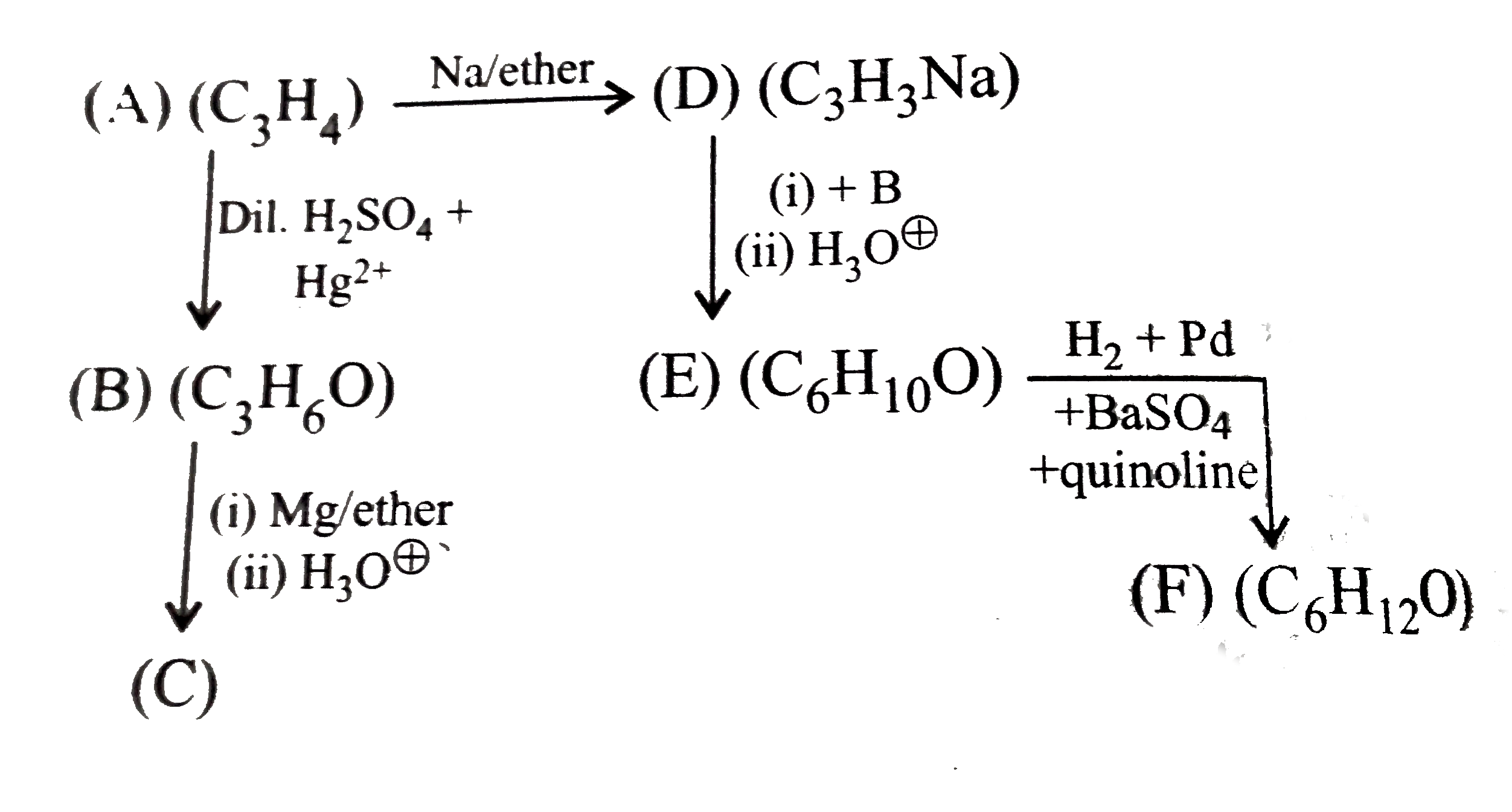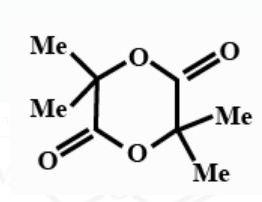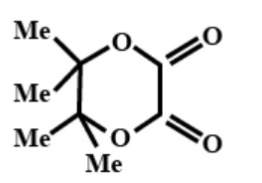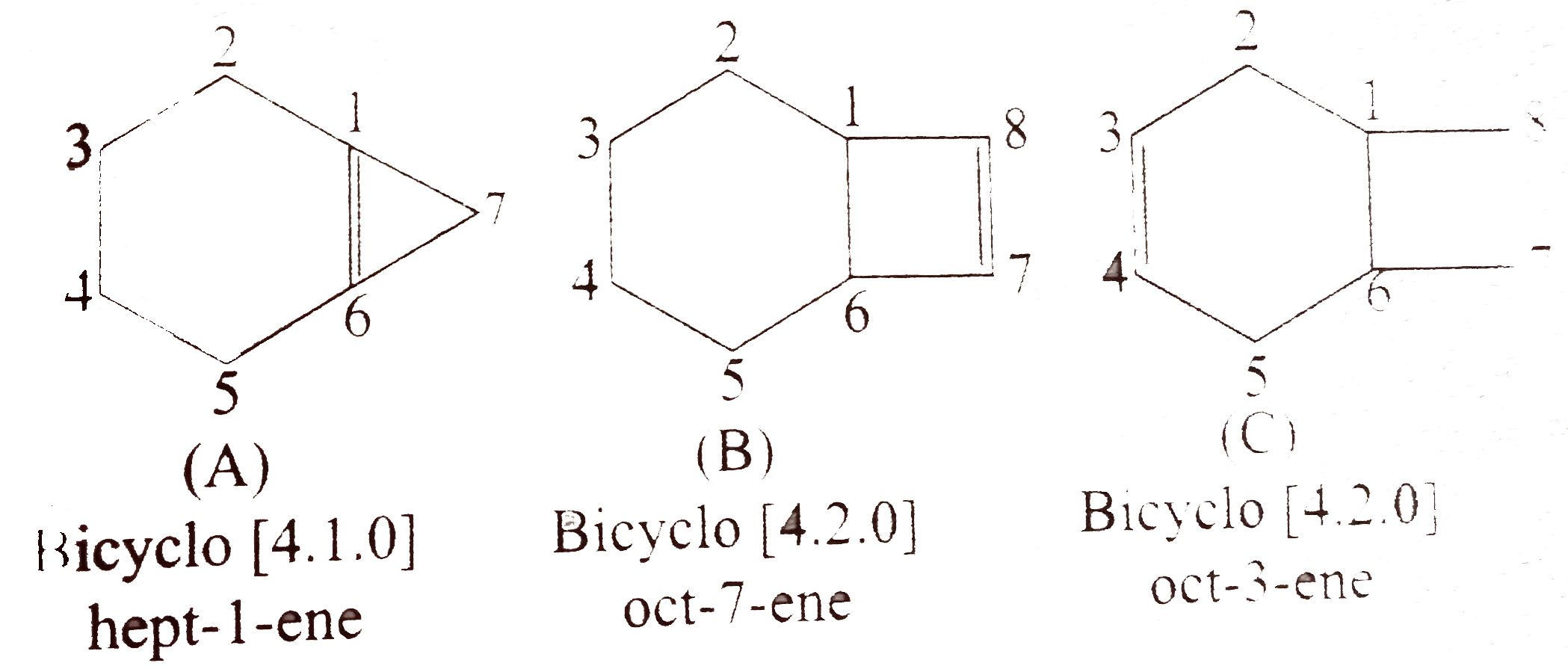Hydrocarbon (A) C6H10 on treatment with H2Ni,H2/Lindlar's catalyst or Na/liq. NH3 forms three different reduction products (B), (C), (D) respectively. (A) does not form any salt with ammonical AgNO3 solution, but (E) forms salt on heating with NaNH2 in an inert solvent. Compound (E) reacts with CH3l to give (F). Compound (D) on oxidative ozonolysis gives n-butanoic acid along with other product.
(F) on ozonolysis will produce -
acetic aicd
formic acid
propanoic acid
formaldehyde
The correct Answer is:A
Step by step video, text & image solution for Hydrocarbon (A) C_(6)H_(10) on treatment with H_(2)/Ni, H_(2)//Lindlar's catalyst or Na//liq. NH_(3) forms three different reduction products (B), (C), (D) respectively. (A) does not form any salt with ammonical AgNO_(3) solution, but (E) forms salt on heating with NaNH_(2) in an inert solvent. Compound (E) reacts with CH_(3)l to give (F). Compound (D) on oxidative ozonolysis gives n-butanoic acid along with other product. (F) on ozonolysis will produce - by Chemistry experts to help you in doubts & scoring excellent marks in Class 12 exams.
Updated on:21/07/2023Topper's Solved these Questions
- ALKENE, ALKANE & ALKYNE BOOK - ALLENCHAPTER - ALKENE, ALKANE & ALKYNE EXERCISE - EXERCISE-4(A)
10 Videos
- ALKENE, ALKANE & ALKYNE BOOK - ALLENCHAPTER - ALKENE, ALKANE & ALKYNE EXERCISE - EXERCISE-4(B)
10 Videos
- ALKENE, ALKANE & ALKYNE BOOK - ALLENCHAPTER - ALKENE, ALKANE & ALKYNE EXERCISE - EXERCISE-1
119 Videos
- AIIMS 2019BOOK - ALLENCHAPTER - AIIMS 2019EXERCISE - CHEMISTRY
35 Videos
- ALKYL AND ARYL HALIDEBOOK - ALLENCHAPTER - ALKYL AND ARYL HALIDEEXERCISE - EXERCISE-05 (B)
37 Videos
Similar Questions
Hydrocarbon (A) C6H10, on treatment with H2/Ni,H2/ Lindlar's catalylst and Na/liquid NH3 forms three different reduction products (B), ( C) and (D) respectiveluy. (A) does not form any salt with ammonial AgNO3 solution, but forms a salt (E) on heating with NaNH2 in an inert solvent. Compound (E) reacts with CH3I to give (F). Compound (D) on oxidative ozonolysis gives n-butanoic acid along with other product.
Give structures of (A) to (F) with proper reasoning.
View SolutionHydrocarbon (A), C6H10 on treatment with H2/Ni,H2/Lindler catalyst and Na /Liquid ammonia forms three different reduction products (B), (C) and (C) respectively. (A) does not form any salt with ammoniacal AgNO3 solution, but forms a salt(E) on heating with NaNH2 in an intert solvent. Compound (E) reacts with CH3I to give (F). Compound (D) on oxidative ozonolysis gives n-butanoic acid along with other product. Give structurs of (A) to (F) with proper reasoning .
View Solution
Knowledge Check
Hydrocarbon (A) C6H10 on treatment with H2Ni,H2/Lindlar's catalyst or Na/liq. NH3 forms three different reduction products (B), (C), (D) respectively. (A) does not form any salt with ammonical AgNO3 solution, but (E) forms salt on heating with NaNH2 in an inert solvent. Compound (E) reacts with CH3l to give (F). Compound (D) on oxidative ozonolysis gives n-butanoic acid along with other product.
If (E) is reaxted with acelaldehyde followed by acidification, product isAacidBketoneCetherDalcoholAH2/Lindlar's catalyst←−−−−−−−−−−−−CH3C≡CCH3Na/Liq NH3−−−−−−−−→B A and B, respectively, are
Acis, trans-but-2-eneBboth trans-but-2-eneCtrans, cis-but-2-eneDboth cis-but-2-ene
The compound F(C6H12O) on oxidative ozonolysis yirlds acetic acid and a compound (G) (C4H8O3). The new compound (G) on heating gives:A BMe−CH=C=CH−EtC
BMe−CH=C=CH−EtC D
D
An organic compound C4H6 on reductive ozonolysis gives HCHO,CO2 and CH3C=CH−CH=CH2 Find structure of compound.
View SolutionGive the products formed on reductive ozonolysis with LAH and oxidative ozonolysis with H2O2, from the compounds in question.
View SolutionBenzene on reaction with HOCl in presence of an acid produces organic compound (A). (A) on treatment with NaNH2/liq. NH3 furnishes another organic compound (B). (B) on treatment with HBF4 affords an organic compound (C) which on heating with NaNO2 gives organic compound (D). Identify (A), (B), (C) and (D).
View SolutionA compound (C5H8) reacts with ammoniacal AgNO3 to give a white precipitate and reacts with excess of KMnO4 solution to give (CH3)2CH−COOH. The compound is
View SolutionThe three compounds (A),(B),and (C) on hydrogenation with H2+Pd give (D),(E) and (F), respectively.

Compounds (D),(E) and (F) are :
View Solution